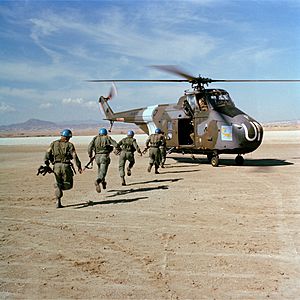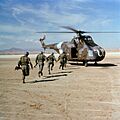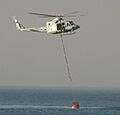No. 84 Squadron RAF facts for kids
Quick facts for kids No. 84 Squadron RAF |
|
|---|---|
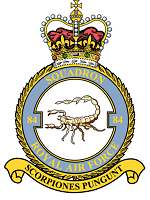
Squadron badge
|
|
| Active |
|
| Country | |
| Branch | |
| Type | Flying squadron |
| Role | Multi-role helicopter support |
| Part of | British Forces Cyprus |
| Home station | RAF Akrotiri, Cyprus |
| Motto(s) | Scorpiones pungunt (Latin for 'Scorpions sting') |
| Aircraft | Puma HC Mk.2 |
| Battle honours |
|
| Commanders | |
| Notable commanders |
|
| Insignia | |
| Squadron badge heraldry | A scorpion, reflecting the squadron's long association with the Middle East. Approved by King George VI in December 1936. |
| Squadron codes | UR (Apr 1939 – Sep 1939) VA (Sep 1939 – Mar 1941) PY (Jan 1945 – Dec 1946) ♠ ♥ ♣ ♦ (Wessex and Griffin) |
No. 84 Squadron is a special unit of the Royal Air Force (RAF). It is currently a Search and Rescue Squadron. This means they help people in danger. They are based at RAF Akrotiri in Cyprus. Their main aircraft is the Puma HC Mk.2 helicopter. They started using the Puma in 2023, after flying the Bell Griffin HAR.2.
As of 2016, 84 Squadron is the only RAF squadron that has never been based in the United Kingdom. It is also one of the last parts of the RAF Search and Rescue Force still active. The main UK search and rescue efforts ended in 2015.
Contents
History of the Squadron
World War I Service
No. 84 Squadron first started on 16 February 1917. It was part of the Royal Flying Corps (RFC). They trained with many different types of planes. In July 1917, they began to get their main fighter plane, the Royal Aircraft Factory S.E.5a.
In September 1917, the squadron moved to France. They flew missions over the Western Front. Their jobs included patrols and escorting other planes. During the Battle of Cambrai, they protected planes attacking targets on the ground. They also fought German planes trying to attack British soldiers.
From December 1917, they also started attacking targets on the ground. This was very important during the German spring offensive in March 1918. One of their pilots, Andrew Beauchamp-Proctor, was very good at shooting down German observation balloons. He also shot down many enemy planes. He even received the Victoria Cross, a very high award. By the end of the war in November 1918, the squadron had shot down 129 German planes and 50 balloons. The squadron was later disbanded in January 1920.
Between the World Wars
The squadron was formed again on 13 August 1920. This time, they were in Baghdad, Iraq. They stayed in the Middle East for about 20 years. During this time, they flew different types of aircraft. These included the Airco DH.9A, Westland Wapiti, Vickers Vincent, and Blenheim Mk.Is.
World War II Operations
The squadron's first combat mission in World War II was on 15 August 1940. Six of their Blenheim planes shot down an Italian plane near Kamaran Island. They moved to Egypt in September 1940. From there, they attacked German forces.
In November 1940, 84 Squadron moved to Greece. They helped support the Greeks against an Italian invasion. They bombed Italian forces and airfields in Albania. When German forces invaded Greece in April 1941, the squadron's planes had to leave quickly.
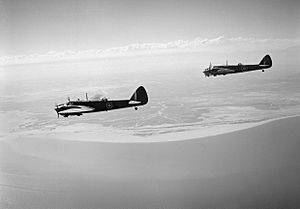
The squadron then moved to Palestine. They helped British forces during a conflict in Iraq in May 1941. They also attacked airfields in Syria that were helping German and Italian forces. After this, they took part in the invasion of Syria and Lebanon. They also helped in the Anglo-Soviet invasion of Iran in August 1941. By November, they were back in Egypt.
In early 1942, the squadron moved to Sumatra and then Java because of the Japanese invasion of Malaya. They lost many planes and people during the Battle of Kalijati in Java. In March 1942, eleven squadron members escaped Java in a lifeboat. They sailed for 47 days and reached Australia. They named their lifeboat 'Scorpion' after the squadron's badge.
The squadron was reformed in Karachi in March 1942. They received more Blenheim planes. Later, in December 1942, they got Vultee Vengeance dive bombers. They moved to Ceylon (now Sri Lanka) in April 1943 to protect the island from Japanese attacks. In February 1944, they started flying missions in Burma. They supported the second Chindit operation and fought against the Japanese attack on Imphal and Kohima.
By July 1944, the Vengeance planes were no longer needed in Burma. The squadron then trained on other aircraft. They received De Havilland Mosquito planes in February 1945. They were still training when World War II ended in September 1945.
After World War II
After the war, the squadron moved to Singapore in September 1945. They also sent a group to Java to help during the Indonesian war of independence. They flew missions against Indonesian forces. In 1946, they moved to Kuala Lumpur in Malaya. Their Mosquito planes had problems, so they got Bristol Beaufighters in November 1946.
In 1949, they received Bristol Brigand planes in Iraq. In 1950, they moved to Tengah Air Base in Singapore. They took part in "Operation Firedog" to fight against rebels during the Malayan Emergency. The Brigand planes had some issues, like cannon explosions and wing cracks. Because of these problems, the Brigands were permanently stopped from flying in January 1953.
The squadron was disbanded on 20 February 1953. But on the same day, another squadron, No. 204 Squadron, was renamed No. 84 Squadron. This new 84 Squadron flew Vickers Valetta transport planes from Egypt. They flew transport missions around the Middle East. In 1956, they moved to RAF Nicosia in Cyprus. They helped in "Operation Musketeer" during the Suez Crisis in November 1956. Their Valettas dropped paratroopers.
In 1956, the squadron moved to RAF Khormaksar in Aden. They continued transport operations. In 1958, they added Blackburn Beverley heavy transport planes. In 1967, the Beverleys were replaced by Hawker Siddeley Andovers. When British forces left Aden, the squadron moved to RAF Sharjah in the United Arab Emirates. The squadron was disbanded again on 31 October 1971.
Return to Cyprus
No. 84 Squadron was reformed on 17 January 1972. They were based at RAF Akrotiri in Cyprus. They flew Westland Whirlwind HAR.10s. Their jobs included supporting the United Nations Peacekeeping Force in Cyprus (UNFICYP) and search and rescue for southern Cyprus. They had two groups: "A" flight for search and rescue (yellow helicopters) and "B" flight for UN support (camouflaged helicopters with blue bands).
After 1975, 84 Squadron became the only RAF squadron permanently based in Cyprus. In December 1981, they replaced the Whirlwind with the Westland Wessex HC.2. Later, in June 1984, they got the Westland Wessex HU.5C. They were the last squadron to use the Westland Wessex.
In 1983, No. 84 Squadron was the first RAF group to go into Beirut during the Lebanese Crisis. They helped evacuate peacekeepers from the city. The job of civil search and rescue in Cyprus was later given to the Cyprus Police.
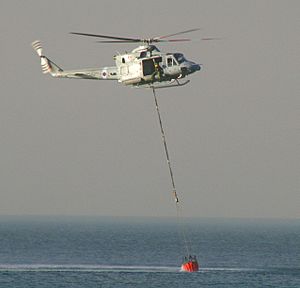
In January 2003, the squadron replaced their Wessexes with four Bell Griffin HAR.2 helicopters. Their main jobs were search and rescue for British forces in Cyprus. They also transported British army units. On 31 March 2023, the squadron changed to Aérospatiale Puma HC Mk.2 helicopters.
Squadron Symbols
The squadron's special badge is a scorpion. This badge was approved by George VI in December 1936. Their motto is Scorpiones pungunt. This is Latin for "Scorpions sting".
Aircraft Operated by the Squadron
Here is a list of the different aircraft that 84 Squadron has flown over the years:
|
|
Notable Squadron Members
Many brave pilots and airmen have served in 84 Squadron. Here are some of the most well-known members, especially those who were "aces" (pilots who shot down five or more enemy aircraft) in World War I:
|
|
Images for kids


